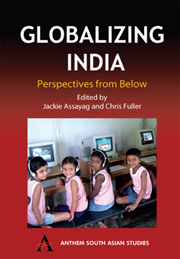Book contents
- Frontmatter
- Contents
- List of Contributors
- Acknowledgements
- 1 Introduction
- Part One Economy and Agriculture
- Part Two Education and Language
- Part Three Culture and Religion
- 8 Maps of Audiences: Bombay Films, the French Territory and the Making of an ‘Oblique’ Market
- 9 Malabar Gods, Nation-Building and World Culture: On Perceptions of the Local and the Global
- 10 Globalizing Hinduism: A ‘Traditional’ Guru and Modern Businessmen in Chennai
- Bibliography
8 - Maps of Audiences: Bombay Films, the French Territory and the Making of an ‘Oblique’ Market
from Part Three - Culture and Religion
Published online by Cambridge University Press: 05 March 2012
- Frontmatter
- Contents
- List of Contributors
- Acknowledgements
- 1 Introduction
- Part One Economy and Agriculture
- Part Two Education and Language
- Part Three Culture and Religion
- 8 Maps of Audiences: Bombay Films, the French Territory and the Making of an ‘Oblique’ Market
- 9 Malabar Gods, Nation-Building and World Culture: On Perceptions of the Local and the Global
- 10 Globalizing Hinduism: A ‘Traditional’ Guru and Modern Businessmen in Chennai
- Bibliography
Summary
For the film producers and distributors of Bombay (Mumbai), the foreign territories (or ‘the Overseas’) are not an abstract entity but an active field of transactions made up of unequally profitable areas. Called ‘the sixth territory’ on the distribution map, the Overseas are in fact a conglomerate of distant and fragmented spaces. If the Middle East, Africa and the traditional locations of the Indian diaspora have been among the privileged destinations for Indian film prints for many years, it seems that several elements altered the film production game significantly at the turn of the twenty-first century and considerably modified the status of the Overseas in the minds of Indian producers.
After the debacle of his film Trimurti (1995), the film director Subhash Ghai declared that he was making his next film Pardesh (shot partly in the United States, partly in Mysore) for the diaspora and that the latter was a more secure market than India itself. In spite of a more limited audience, the diaspora was offering incomparable profits and paradoxically seemed, to many filmmakers, to be more receptive and easier to reach than the local audience. The producers often used the rhetoric of globalization to justify strategic attempts to redirect their efforts towards this distant public, presented in the film press as an Eldorado to escape the crisis of local taste variability. This reorientation also seemed quite safe for many film professionals because it did not imply a major redefinition of their narrative conventions.
- Type
- Chapter
- Information
- Globalizing IndiaPerspectives from Below, pp. 165 - 184Publisher: Anthem PressPrint publication year: 2005
- 10
- Cited by



